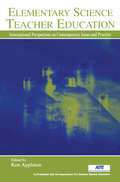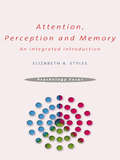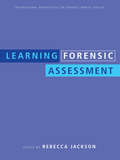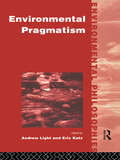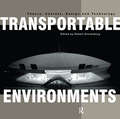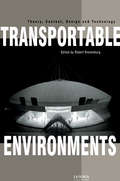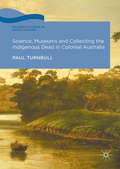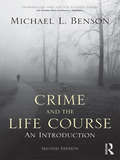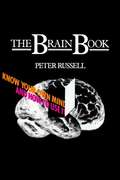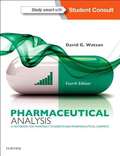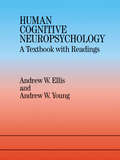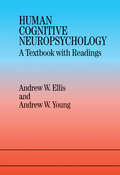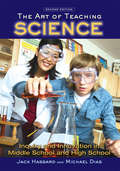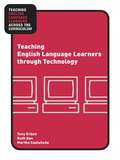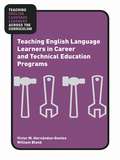- Table View
- List View
Elementary Science Teacher Education: International Perspectives on Contemporary Issues and Practice
by Ken AppletonCo-Published with the Association For Science Teacher Education. Reflecting recent policy and standards initiatives, emerging research agendas, and key innovations, this volume provides a contemporary overview of important developments and issues that have that have in recent years shaped elementary science education pre-service courses and professional development, and practices that are shaping future directions in the field. Contributors from several countries who are actively engaged in research and design in elementary science education address:*Conceptual issues which impinge on contemporary science teacher education;*Intersections of content, pedagogy, and practice; and*Professional development as a contextualized practice.Elementary Science Teacher Education: International Perspectives on Contemporary Issues and Practice offers a clear picture of the current state of the field and directions for the future--to the benefit of elementary science teacher educators, aspiring teacher educators, school policy makers, other professionals involved in science education and, ultimately, the millions of elementary school children who will gain from improved practice.
Elementary Science Teacher Education: International Perspectives on Contemporary Issues and Practice
by Ken AppletonCo-Published with the Association For Science Teacher Education. Reflecting recent policy and standards initiatives, emerging research agendas, and key innovations, this volume provides a contemporary overview of important developments and issues that have that have in recent years shaped elementary science education pre-service courses and professional development, and practices that are shaping future directions in the field. Contributors from several countries who are actively engaged in research and design in elementary science education address:*Conceptual issues which impinge on contemporary science teacher education;*Intersections of content, pedagogy, and practice; and*Professional development as a contextualized practice.Elementary Science Teacher Education: International Perspectives on Contemporary Issues and Practice offers a clear picture of the current state of the field and directions for the future--to the benefit of elementary science teacher educators, aspiring teacher educators, school policy makers, other professionals involved in science education and, ultimately, the millions of elementary school children who will gain from improved practice.
Attention, Perception and Memory: An Integrated Introduction
by Elizabeth StylesAlthough attention, perception and memory are identifiable components of the human cognitive system, this book argues that for a complete understanding of any of them it is necessary to appreciate the way they interact and depend on one another. Using close examination of experiments, studies of patients and evidence from cognitive neuroscience, each of these important areas in cognitive psychology is explored in detail and related to its counterparts. Written by an established author, Attention, Perception and Memory: An Integrated Introduction explains clearly the evolution and meaning of key terminology and assumptions and puts the different approaches to this field in context.
Attention, Perception and Memory: An Integrated Introduction
by Elizabeth StylesAlthough attention, perception and memory are identifiable components of the human cognitive system, this book argues that for a complete understanding of any of them it is necessary to appreciate the way they interact and depend on one another. Using close examination of experiments, studies of patients and evidence from cognitive neuroscience, each of these important areas in cognitive psychology is explored in detail and related to its counterparts. Written by an established author, Attention, Perception and Memory: An Integrated Introduction explains clearly the evolution and meaning of key terminology and assumptions and puts the different approaches to this field in context.
Learning Forensic Assessment
by Rebecca JacksonProviding an excellent resource for forensic psychology undergraduate students, this book offers students the opportunity to learn from experts, through the collection of outstanding articles. Unlike other books in the area that are topic specific, it also gives them comprehensive coverage of the subject. Divided into five broad topic areas, it covers: professional issues juvenile assessment criminal forensic assessment civil forensic assessment pervasive issues – malingering and psychopathy. Written by a group of internationally renowned contributors and including didactic information as well as providing discussions on practical issues regarding assessment and assessment instruments, this textbook will be invaluable reading for all students of forensic psychology.
Learning Forensic Assessment
by Rebecca JacksonProviding an excellent resource for forensic psychology undergraduate students, this book offers students the opportunity to learn from experts, through the collection of outstanding articles. Unlike other books in the area that are topic specific, it also gives them comprehensive coverage of the subject. Divided into five broad topic areas, it covers: professional issues juvenile assessment criminal forensic assessment civil forensic assessment pervasive issues – malingering and psychopathy. Written by a group of internationally renowned contributors and including didactic information as well as providing discussions on practical issues regarding assessment and assessment instruments, this textbook will be invaluable reading for all students of forensic psychology.
Environmental Pragmatism
by Eric Katz Andrew LightEnvironmental pragmatism is a new strategy in environmental thought. It argues that theoretical debates are hindering the ability of the environmental movement to forge agreement on basic policy imperatives. This new direction in environmental thought moves beyond theory, advocating a serious inquiry into the merits of moral pluralism. Environmental pragmatism, as a coherent philosophical position, connects the methodology of classical American pragmatic thought to the explanation, solution and discussion of real issues. This concise, well-focused collection is the first comprehensive presentation of environmental pragmatism as a new philosophical approach to environmental thought and policy.
Environmental Pragmatism
by Eric Katz Andrew LightEnvironmental pragmatism is a new strategy in environmental thought. It argues that theoretical debates are hindering the ability of the environmental movement to forge agreement on basic policy imperatives. This new direction in environmental thought moves beyond theory, advocating a serious inquiry into the merits of moral pluralism. Environmental pragmatism, as a coherent philosophical position, connects the methodology of classical American pragmatic thought to the explanation, solution and discussion of real issues. This concise, well-focused collection is the first comprehensive presentation of environmental pragmatism as a new philosophical approach to environmental thought and policy.
Transportable Environments
by Robert KronenburgTransportable Environments explores aspects of the historical and theoretical basis for portable architecture and provides an insight into the wide range of functions that it is used for today, the varied forms that it takes and the concerns and ideas for its future development. Written by a team of international commentators, this volume provides a state-of-the-art survey of this specialist area and will be of interest to a wide range of professionals across the construction and design industries.
Transportable Environments
by Robert KronenburgTransportable Environments explores aspects of the historical and theoretical basis for portable architecture and provides an insight into the wide range of functions that it is used for today, the varied forms that it takes and the concerns and ideas for its future development. Written by a team of international commentators, this volume provides a state-of-the-art survey of this specialist area and will be of interest to a wide range of professionals across the construction and design industries.
Science, Museums and Collecting the Indigenous Dead in Colonial Australia
by Paul TurnbullThis book draws on over twenty years’ investigation of scientific archives in Europe, Australia, and other former British settler colonies. It explains how and why skulls and other bodily structures of Indigenous Australians became the focus of scientific curiosity about the nature and origins of human diversity from the early years of colonisation in the late eighteenth century to Australia achieving nationhood at the turn of the twentieth century. The last thirty years have seen the world's indigenous peoples seek the return of their ancestors' bodily remains from museums and medical schools throughout the western world. Turnbull reveals how the remains of the continent's first inhabitants were collected during the long nineteenth century by the plundering of their traditional burial places. He also explores the question of whether museums also acquired the bones of men and women who were killed in Australian frontier regions by military, armed police and settlers.
Science, Museums and Collecting the Indigenous Dead in Colonial Australia
by Paul TurnbullThis book draws on over twenty years’ investigation of scientific archives in Europe, Australia, and other former British settler colonies. It explains how and why skulls and other bodily structures of Indigenous Australians became the focus of scientific curiosity about the nature and origins of human diversity from the early years of colonisation in the late eighteenth century to Australia achieving nationhood at the turn of the twentieth century. The last thirty years have seen the world's indigenous peoples seek the return of their ancestors' bodily remains from museums and medical schools throughout the western world. Turnbull reveals how the remains of the continent's first inhabitants were collected during the long nineteenth century by the plundering of their traditional burial places. He also explores the question of whether museums also acquired the bones of men and women who were killed in Australian frontier regions by military, armed police and settlers.
Crime and the Life Course
by Michael BensonIn recent years, the lifecourse perspective has become a popular theoretical orientation toward crime. Yet despite its growing importance in the field of criminology, most textbooks give it only cursory treatment. Crime and the Lifecourse: An Introduction by Michael L. Benson provides a comprehensive overview of contemporary research and theory on the life-course approach to crime. The book emphasizes a conceptual understanding of this approach. A special feature is the integration of qualitative and quantitative research on criminal life histories. This book: provides an overview of the life course approach and describes the major concepts and issues in lifecourse theory as it applies to criminology reviews evidence on biological and genetic influences on crime reviews research on the role of the family in crime and juvenile delinquency provides a detailed discussion of the criminological lifecourse theories of Moffitt, Hagan, Sampson and Laub, and others discusses the connections between youthful crime and adult outcomes in education, occupation, and marriage presents an application of the lifecourse approach to white-collar crime discusses how macro sociological and historical developments have influenced the shape of the lifecourse in American society as it relates to patterns in crime.
Crime and the Life Course
by Michael BensonIn recent years, the lifecourse perspective has become a popular theoretical orientation toward crime. Yet despite its growing importance in the field of criminology, most textbooks give it only cursory treatment. Crime and the Lifecourse: An Introduction by Michael L. Benson provides a comprehensive overview of contemporary research and theory on the life-course approach to crime. The book emphasizes a conceptual understanding of this approach. A special feature is the integration of qualitative and quantitative research on criminal life histories. This book: provides an overview of the life course approach and describes the major concepts and issues in lifecourse theory as it applies to criminology reviews evidence on biological and genetic influences on crime reviews research on the role of the family in crime and juvenile delinquency provides a detailed discussion of the criminological lifecourse theories of Moffitt, Hagan, Sampson and Laub, and others discusses the connections between youthful crime and adult outcomes in education, occupation, and marriage presents an application of the lifecourse approach to white-collar crime discusses how macro sociological and historical developments have influenced the shape of the lifecourse in American society as it relates to patterns in crime.
The Brain Book: Know Your Own Mind and How to Use it
by Peter RussellFirst published in 1980. Routledge is an imprint of Taylor & Francis, an informa company.
Pharmaceutical Analysis: A Textbook For Pharmacy Students And Pharmaceutical Chemists (PDF)
by David G. WatsonPharmaceutical analysis forms a core part of any pharmacy programme, as well as being essential for pharmacology and medicinal chemistry courses. Pharmaceutical analysis determines the purity, concentration, active compounds, shelf life, rate of absorption in the body, identity, stability, rate of release etc. of a drug. Testing a pharmaceutical product involves a variety of analyses, and the analytical processes described in this book are used in industries as diverse as food, beverages, cosmetics, detergents, metals, paints, water, agrochemicals, biotechnological products and pharmaceuticals. The mathematics involved is notoriously difficult, but this much-praised textbook, now revised and updated for its fourth edition, guides a student through the complexities with clear writing and the author's expertise from many years' teaching pharmacy students. There is continuous learning reinforcement throughout the book by way of worked calculation examples and self-assessment test questions. Worked calculation examples Self-assessment Additional problems (self tests) Practical boxes Key points boxes New chapter on electrochemical biosensors. New chapter on the quality control of biotechnologically produced drugs. Extended chapter on molecular emission spectroscopy. Now comes with an e-book on StudentConsult. Self-assessment is interactive in the accompanying online e-book. 65 online animations show concepts such as ionization partitioning of drug molecules etc. ~
Human Cognitive Neuropsychology: A Textbook With Readings
by Andrew W. Ellis Andrew W. YoungThis textbook augments the first edition through the inclusion of a set of reseach and review papers selected by the authors to supplement the contents of each chapter by providing a discussion of research issues and detailed investigation of individual cases. One or two papers supplement each chapter. A short introduction to each set makes clear the nature of their contribution and how they relate to each chapter's contents. Some of the papers are short reviews of theoretical contributions; others are case studies in the tradition of cognitive neuropsychology. At least three of the main trends discernible in cognitive neuropsychology in the 1990s are represented in the chosen papers. The first is the use of connectionist models to simulate patterns of impairment in brain-injured patients. The second is the growing convergence between cognitive neuropsychology and neuroscience: cognitive neuropsychologists are becoming increasingly interested in the brain processes that underlie the preserved and damaged psychological processes they study. The third trend is the involvement of cognitive neuropsychologists in work on therapy and rehabilitation.
Human Cognitive Neuropsychology: A Textbook With Readings
by Andrew W. Ellis Andrew W. YoungThis textbook augments the first edition through the inclusion of a set of reseach and review papers selected by the authors to supplement the contents of each chapter by providing a discussion of research issues and detailed investigation of individual cases. One or two papers supplement each chapter. A short introduction to each set makes clear the nature of their contribution and how they relate to each chapter's contents. Some of the papers are short reviews of theoretical contributions; others are case studies in the tradition of cognitive neuropsychology. At least three of the main trends discernible in cognitive neuropsychology in the 1990s are represented in the chosen papers. The first is the use of connectionist models to simulate patterns of impairment in brain-injured patients. The second is the growing convergence between cognitive neuropsychology and neuroscience: cognitive neuropsychologists are becoming increasingly interested in the brain processes that underlie the preserved and damaged psychological processes they study. The third trend is the involvement of cognitive neuropsychologists in work on therapy and rehabilitation.
The Art of Teaching Science: Inquiry and Innovation in Middle School and High School
by Jack Hassard Michael DiasThe Art of Teaching Science emphasizes a humanistic, experiential, and constructivist approach to teaching and learning, and integrates a wide variety of pedagogical tools. Becoming a science teacher is a creative process, and this innovative textbook encourages students to construct ideas about science teaching through their interactions with peers, mentors, and instructors, and through hands-on, minds-on activities designed to foster a collaborative, thoughtful learning environment. This second edition retains key features such as inquiry-based activities and case studies throughout, while simultaneously adding new material on the impact of standardized testing on inquiry-based science, and explicit links to science teaching standards. Also included are expanded resources like a comprehensive website, a streamlined format and updated content, making the experiential tools in the book even more useful for both pre- and in-service science teachers. Special Features: Each chapter is organized into two sections: one that focuses on content and theme; and one that contains a variety of strategies for extending chapter concepts outside the classroom Case studies open each chapter to highlight real-world scenarios and to connect theory to teaching practice Contains 33 Inquiry Activities that provide opportunities to explore the dimensions of science teaching and increase professional expertise Problems and Extensions, On the Web Resources and Readings guide students to further critical investigation of important concepts and topics. An extensive companion website includes even more student and instructor resources, such as interviews with practicing science teachers, articles from the literature, chapter PowerPoint slides, syllabus helpers, additional case studies, activities, and more. Visit http://www.routledge.com/textbooks/9780415965286 to access this additional material.
The Art of Teaching Science: Inquiry and Innovation in Middle School and High School
by Jack Hassard Michael DiasThe Art of Teaching Science emphasizes a humanistic, experiential, and constructivist approach to teaching and learning, and integrates a wide variety of pedagogical tools. Becoming a science teacher is a creative process, and this innovative textbook encourages students to construct ideas about science teaching through their interactions with peers, mentors, and instructors, and through hands-on, minds-on activities designed to foster a collaborative, thoughtful learning environment. This second edition retains key features such as inquiry-based activities and case studies throughout, while simultaneously adding new material on the impact of standardized testing on inquiry-based science, and explicit links to science teaching standards. Also included are expanded resources like a comprehensive website, a streamlined format and updated content, making the experiential tools in the book even more useful for both pre- and in-service science teachers. Special Features: Each chapter is organized into two sections: one that focuses on content and theme; and one that contains a variety of strategies for extending chapter concepts outside the classroom Case studies open each chapter to highlight real-world scenarios and to connect theory to teaching practice Contains 33 Inquiry Activities that provide opportunities to explore the dimensions of science teaching and increase professional expertise Problems and Extensions, On the Web Resources and Readings guide students to further critical investigation of important concepts and topics. An extensive companion website includes even more student and instructor resources, such as interviews with practicing science teachers, articles from the literature, chapter PowerPoint slides, syllabus helpers, additional case studies, activities, and more. Visit http://www.routledge.com/textbooks/9780415965286 to access this additional material.
Teaching English Language Learners through Technology
by Tony Erben Ruth Ban Martha CastañedaIn Teaching English Language Learners through Technology, the authors explore the use of computers/technology as a pedagogical tool to aid in the appropriate instruction of ELLs across all content areas. The special focus of this book is on the informed use of various technologies and software programs that can specifically aid ELLs. Strategies are also provided for varying levels of access--whether teachers teach in a one computer classroom, have access to multiple computers, or have the ability to go into a computer lab at their school. A fully annotated list of web and print resources completes the volume, making this a valuable reference to help teachers harness the power of computer-assisted technologies in meeting the challenges of including all learners in effective instruction.
Teaching English Language Learners through Technology
by Tony Erben Ruth Ban Martha CastañedaIn Teaching English Language Learners through Technology, the authors explore the use of computers/technology as a pedagogical tool to aid in the appropriate instruction of ELLs across all content areas. The special focus of this book is on the informed use of various technologies and software programs that can specifically aid ELLs. Strategies are also provided for varying levels of access--whether teachers teach in a one computer classroom, have access to multiple computers, or have the ability to go into a computer lab at their school. A fully annotated list of web and print resources completes the volume, making this a valuable reference to help teachers harness the power of computer-assisted technologies in meeting the challenges of including all learners in effective instruction.
Teaching English Language Learners in Career and Technical Education Programs
by Victor M. Hernández-Gantes William BlankExploring the unique challenges of vocational education, this book provides simple and straightforward advice on how to teach English Language Learners in today's Career and Technical Education programs. The authors' teaching framework and case studies draw from common settings in which career and technical educators find themselves working with ELLs—in the classroom, in the laboratory or workshop, and in work-based learning settings. By integrating CTE and academic instruction, and embedding career development activities across the curriculum, readers will gain a better understanding of the challenges of teaching occupationally-oriented content to a diverse group of learners in multiples settings.
Teaching English Language Learners in Career and Technical Education Programs
by Victor M. Hernández-Gantes William BlankExploring the unique challenges of vocational education, this book provides simple and straightforward advice on how to teach English Language Learners in today's Career and Technical Education programs. The authors' teaching framework and case studies draw from common settings in which career and technical educators find themselves working with ELLs—in the classroom, in the laboratory or workshop, and in work-based learning settings. By integrating CTE and academic instruction, and embedding career development activities across the curriculum, readers will gain a better understanding of the challenges of teaching occupationally-oriented content to a diverse group of learners in multiples settings.
Women Working In The Environment: Resourceful Natures
by Carolyn E. SachsBased on theoretical insights from ecofeminism, women and development, and postmodernism, and the convincing empirical work of numerous scholars, this book is organized around five aspects of gender relationships with the environment: Part I-gender divisions of labor, Part 2-property rights, Part 3-knowledge and strategies for sustainability, Part 4-environmental and social movements, and Part 5- policy alternatives. Examining women's relationship with the environment using these five dimensions provides concrete, material examples of how women work with, control, know, and affect the environment and natural resources.
